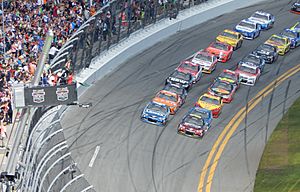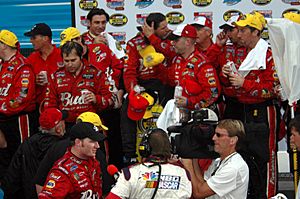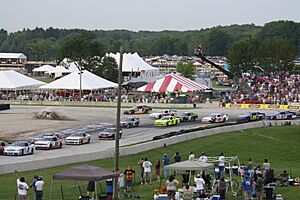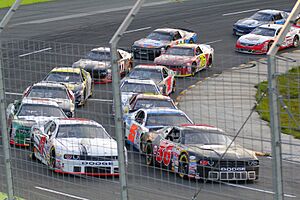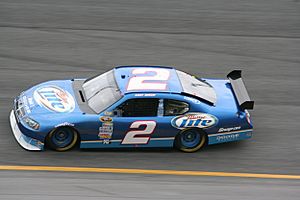NASCAR facts for kids
| Sport | Auto racing |
|---|---|
| Category | Stock car racing Sports car racing (IMSA) |
| Abbreviation | NASCAR |
| Founded | February 21, 1948 |
| Affiliation | ACCUS-FIA |
| Headquarters | Daytona Beach, Florida, U.S. (main) Charlotte, North Carolina, U.S. Concord, North Carolina, U.S. |
| President | Steve O'Donnell Peter Jung (Vice President, CMO) |
| Chairman | Jim France |
| Chairperson | Mike Helton (Vice Chairman) |
| CEO | Jim France |
| Other key staff |
|
| Official website | |
The National Association for Stock Car Auto Racing, LLC (NASCAR) is an American company that organizes and runs auto racing events. It is most famous for its stock car racing series. NASCAR is one of the biggest and most popular motorsports groups in the world. It is also one of the largest spectator sports in America.
Bill France Sr. started the company in 1948. His son, Jim France, has been the CEO since August 2018. NASCAR's main office is in Daytona Beach, Florida. Each year, NASCAR organizes over 1,500 races. These races happen at more than 100 tracks in 48 US states. They also take place in Canada, Mexico, Brazil, and Europe.
NASCAR and stock car racing began with people who secretly transported alcohol during a time called Prohibition. These drivers would race each other to show off their skills. This was especially popular in North Carolina. In 1935, Bill France Sr. started races in Daytona Beach. He wanted to make sure drivers were paid fairly, unlike other race organizers. His races were a big hit, and NASCAR was officially founded in 1948.
NASCAR has different racing levels, like a ladder. The top level is the Cup Series. The Xfinity Series is second, and the Truck Series is third. There are also smaller series below these. Car brands like Chevrolet, Ford, and Toyota compete in all these series. Most NASCAR drivers are from the United States. However, drivers from Canada, Mexico, Europe, and other places have also raced. All Cup Series races are held in the United States and Mexico. A season has 36 main races, plus special pre-season and mid-season events. NASCAR races mostly on oval tracks, including very fast superspeedways and smaller short tracks. They also race on road courses and street circuits.
Richard Petty holds the record for most Cup Series wins with 200 victories. He is tied with Dale Earnhardt and Jimmie Johnson for the most championships, with seven each. As of the 2025 season, Joey Logano is the current Cup Series champion.
Contents
History of NASCAR Racing
How Stock Car Racing Started

In the 1920s and 1930s, Daytona Beach became famous for setting world land speed records. Many records were set on the Daytona Beach Road Course between 1905 and 1935. By 1936, Daytona Beach was known for fast cars. Drivers raced on a 4.1-mile (6.6 km) course. It included a long stretch of beach and a narrow highway. The turns were tight and sandy.
Stock car racing in the United States began with people who transported illegal alcohol. This happened during Prohibition. These drivers needed fast cars to avoid the police. They often changed their cars to make them quicker and handle better. They also made cars hold more cargo.
When Prohibition ended in 1933, some of this business stopped. But people in the American South still liked illegal alcohol. Many drivers kept transporting it, now avoiding tax collectors. Their cars kept getting better. By the late 1940s, races with these cars were held for fun and money. These races were very popular in the rural Southern United States. They are most linked to the Wilkes County area of North Carolina. Most races back then used modified cars. Regular cars were made lighter and stronger.
Important People in NASCAR
William France Sr.
William France Sr. was a mechanic. He moved to Daytona Beach, Florida, in 1935. He wanted to escape the Great Depression. France knew about the area's history with land speed records. He raced in the 1936 Daytona event and finished fifth. He started managing the race course in 1938. He promoted a few races before World War II.
France believed people would enjoy watching stock cars race. Drivers were often cheated by dishonest promoters. These promoters would leave with all the prize money before paying the drivers. On December 14, 1947, France met with other racers and promoters. They met at the Ebony Bar in the Streamline Hotel in Daytona Beach, Florida. This led to the creation of NASCAR on February 21, 1948.
Erwin "Cannonball" Baker
The first leader of NASCAR was Erwin "Cannonball" Baker. He was a former stock car, motorcycle, and open-wheel racer. He competed in the Indianapolis 500. Baker set over one hundred land speed records. He was most famous for driving cars across the country very fast. He would drive from New York to Los Angeles to show how good a car was. After he passed away, the famous cross-country race 'Cannonball Run' was named after him. A movie inspired by the race also used his name.
Baker is honored in several Halls of Fame. These include the Automotive Hall of Fame and the Motorcycle Hall of Fame. He is also in the Indianapolis Motor Speedway Hall of Fame. Because of his success in many types of racing, Baker was called the "King of the Road."
Bob "Barky" Barkhimer
In the early 1950s, Bill France Jr. was stationed in California with the United States Navy. His father asked him to find Bob Barkhimer in San Jose, California. Barkhimer was a famous midget car racing driver from the World War II era. Later, he ran about 22 different speedways. He was the head of the California Stock Car Racing Association. Young Bill France Jr. became good friends with Bob Barkhimer and his partner, Margo Burke. He went to races with them and stayed at their home on weekends. He learned a lot about racing on the west coast. "Barky" later visited Bill France Sr. in Daytona Beach. In the spring of 1954, NASCAR began to organize stock car races on the Pacific Coast under Barky's leadership.
Wendell Scott
Wendell Scott was the first African-American driver to win a race in the Grand National Series. This was NASCAR's highest level at the time. He was honored after his death and added to the NASCAR Hall of Fame. This happened in Charlotte, North Carolina, on January 30, 2015.
How NASCAR Was Founded
On March 8, 1936, many drivers gathered at Daytona Beach, Florida. They brought different types of cars to race. They wanted to find out which cars and drivers were the fastest. During the race, heavier cars got stuck in the sand. Lighter Fords did better, taking the top 6 spots. Out of 27 cars that started, only 10 finished. Officials stopped the race 10 miles (16 km) early. Driver Milt Marion was named the winner. A young Bill France finished 5th that day.
By early 1947, Bill France saw a chance for a single, organized racing series. France announced the "National Championship Stock Car Circuit" (NCSCC). He asked the American Automobile Association (AAA) for money to support it. When AAA said no, France announced his own rules and prizes for the NCSCC. He said the 1947 NCSCC season winner would get $1,000 and a trophy. The season started in January 1947 in Daytona Beach. It ended in Jacksonville that December. Nearly 40 races were held, and many people came to watch. Drivers were paid as promised. By the end of the season, Fonty Flock was champion. He won 7 of the 24 races he entered. Bill France gave Flock the $1,000 and a 4-foot tall trophy. He also gave $3,000 in prize money to other drivers.
After the 1947 season, Bill France announced meetings at the Streamline Hotel in Florida. They started on December 14, 1947. France began the meeting with 35 men who represented the NCSCC. They met on the top floor of the hotel. This was the first of four meetings where France shared his idea for an organized racing group. The first name chosen was "National Stock Car Racing Association." But that name was already in use. So, "National Association for Stock Car Auto Racing," suggested by mechanic Red Vogt, was chosen.
William France, Sr. officially founded NASCAR on February 21, 1948. He had help from other drivers. NASCAR's first plans included three types of racing: Modified, Roadster, and Strictly Stock. The roadster division was quickly dropped. The modified division now runs as the NASCAR Whelen Modified Tour. The Strictly Stock division was delayed. This was because car makers could not build family cars fast enough after World War II. The 1948 schedule had 52 Modified dirt track races. NASCAR held its first event at Daytona Beach on February 15, 1948. Red Byron won the Modified division race, beating Marshall Teague. Byron won the 1948 national championship. By 1949, things had changed. The Strictly Stock division started with a 20-mile (32 km) show race near Miami in February.
The first NASCAR "Strictly Stock" race was at Charlotte Speedway. This is not the same track as the current Charlotte Motor Speedway. The race was on June 19, 1949. Driver Jim Roper won after Glenn Dunaway was disqualified. Dunaway's car had illegal rear springs. At first, these cars were called "Strictly Stock." They raced with almost no changes from factory models. This division was renamed "Grand National" in 1950. Over more than ten years, changes for safety and speed were allowed. By the mid-1960s, the cars were special race cars. They just looked like stock cars.
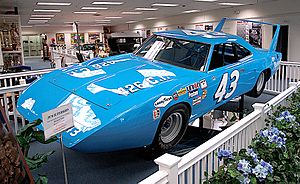
Early in NASCAR's history, car makers from other countries wanted to join. The British car company, MG, had some of its cars race. For example, on August 16, 1963, Smokey Cook drove an MG to finish 17th in the International 200 race.
The first NASCAR race outside the US was in Canada. On July 1, 1952, Buddy Shuman won a 200-lap race. It was on a half-mile (800 m) dirt track in Stamford Park, Ontario, near Niagara Falls.
NASCAR Racing Series
National Series
NASCAR Cup Series
The NASCAR Cup Series (NCS) is the highest level of professional racing in NASCAR. It is the most popular and profitable NASCAR series. Since 2001, the Cup Series season has had 36 races over 10 months. People often just say "Cup" or "NASCAR" when talking about this series. The 2024 NCS Champion is Joey Logano.
Three drivers hold the record for most championships with 7 each: Richard Petty, Dale Earnhardt, and Jimmie Johnson. Johnson holds the record for most championships in a row. He won five straight Cup Series titles from 2006 to 2010. Before him, Cale Yarborough won three in a row in the late 1970s.
The Cup Series got its first main sponsor in 1972. R. J. Reynolds Tobacco Company became the sponsor. They were not allowed to advertise on TV. They found that NASCAR fans were a good group to reach. So, the Grand National Series became the Winston Cup Series in 1971. It had a new points system and good cash prizes for championship points. In 1972, the season was shortened from 48 races to 31. This year is often seen as the start of NASCAR's "modern era." The next racing level, called Late Model Sportsman, took the "Grand National" name. It soon got a sponsor, Busch Beer.
In 2004, Nextel Communications became the main sponsor. The series was renamed the Nextel Cup Series. A new points system, the "Chase for the Nextel Cup," was also created. This system reset points with ten races left. Only drivers in the top ten or close to the leader could win the championship. In 2007, NASCAR expanded "The Chase" to twelve drivers. They removed the point cutoff. The top twelve drivers got a ten-point bonus for each race they won in the first 26 races. Wins throughout the season also gave five more points. In 2008, the series name became the Sprint Cup Series. This happened because Nextel and Sprint merged.
In 2011, NASCAR announced big rule changes. The biggest was changing the points system. The winner of a race got 43 points. Each spot after that got one less point (42 for second, 41 for third, and so on). The winner also got 3 bonus points. Drivers who led a lap got one bonus point. The driver who led the most laps also got a bonus point. Another big change was how drivers qualified for the Chase. There were still 12 qualifying drivers. But only the top 10 qualified based on regular-season points. The last two Chase spots went to the two drivers (from 11th to 20th in points) with the most race wins in the regular season.
In 2014, NASCAR changed the Chase format again. It expanded the Chase to 16 drivers. Four drivers were removed after every three races. This left four drivers to race for the championship at the final race in Homestead. Wins became more important. The 16 drivers with the most wins got a spot in the Chase. If there were fewer than 16 winners, the remaining spots were filled by the regular points system.
Monster Energy became the main sponsor in 2017. The series name changed to Monster Energy NASCAR Cup Series. With Monster Energy's sponsorship, NASCAR also stopped using "The Chase" name. The last 10 races are now called "the playoffs," like in other sports.
After the 2019 season, NASCAR did not accept Monster Energy's offer to stay as the main sponsor. On December 5, NASCAR showed its new sponsorship plan. Instead of one main sponsor, there would be four "premier partners." These were Coca-Cola, Xfinity, Busch Beer, and GEICO. These partners would be closely linked to the top series. The series was simply renamed the NASCAR Cup Series.
NASCAR Xfinity Series
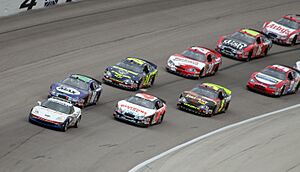
The NASCAR Xfinity Series is the second-highest level of professional racing in NASCAR. The most recent series champion is Justin Allgaier in 2024. This series started in its modern form in 1982. It was sponsored by Anheuser-Busch Brewing's Budweiser brand. In 1984, it was renamed the Busch Grand National Series, then later just the Busch Series. The Anheuser-Busch sponsorship ended in 2007. Nationwide Insurance took over from 2008 to 2014. Now, Comcast sponsors the series through its Xfinity brand.
The Xfinity season usually has fewer races than the Cup Series. The prize money is also much lower. However, for several years, many Cup Series drivers raced in both Xfinity and Cup Series events each weekend. They used the Xfinity race as practice for the Cup event. Also, some drivers raced full-time in both series. Kevin Harvick was the first Cup series driver to race full-time in the Busch Series and win a title. He did this twice. In 2001, he had to race in the Cup series earlier than planned because of Dale Earnhardt's passing. His win in 2006 was the first of five straight titles in this series won by Cup series regulars.
This practice was criticized. People thought it gave Cup Series teams an unfair advantage. They also felt that Cup Series drivers took spots from Xfinity Series drivers who could have qualified. These drivers who raced in both series were called "Buschwhackers." In May 2007, NASCAR said it was looking into this issue. One idea was for Cup Series drivers to not get points for racing in Xfinity races. In 2007, NASCAR chairman Brian France said all options were being considered, except banning Cup drivers completely. On January 11, 2011, NASCAR.com reported a new rule. Starting in 2011, drivers could only compete for the championship in one of NASCAR's three national series each season. They could still race in multiple series, but only earn points for one. This rule was confirmed by France and has been part of NASCAR rules ever since.
Starting in 2010, the Nationwide cars began to look like the "Car of Tomorrow" (COT) design used by Cup cars. They had different bodies from the Cup Series cars.
In 2016, the Chase format was also used for the Xfinity and Truck Series. The Xfinity Series Chase has three rounds and seven races. It involves 12 drivers, not 16 like the Cup Series. Four drivers are removed after each round in the Xfinity Series Chase. This means four drivers are left to compete for the title in the final race, just like in the Cup Series. Starting in 2017, "The Chase" name was dropped. The final seven races are now called the Xfinity Playoffs.
Even with rules limiting points to one series, Cup drivers still won most Xfinity series races through 2015. Starting with the 2015 season finale, NASCAR added more rules for Cup drivers in Xfinity races. From the 2020 season, Cup drivers with more than three years of experience in the top series could only race in five Xfinity races per season. Also, these drivers could not race in the regular season finale, Xfinity playoff races, or Dash 4 Cash races.
NASCAR Craftsman Truck Series
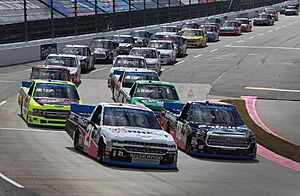
The NASCAR Craftsman Truck Series features modified pickup trucks. It is one of NASCAR's three national divisions. The other two are the Xfinity and Cup Series. The most recent series champion is Ty Majeski in 2024.
In 1994, NASCAR announced the NASCAR SuperTruck Series. It was presented by Craftsman. The first race was in 1995. In 1996, the series was renamed the NASCAR Craftsman Truck Series. This was to highlight Craftsman's involvement. At first, some thought the series was strange or for older drivers. But it became popular. Drivers like Kurt Busch and Carl Edwards moved straight to the Cup Series from the Truck Series. Also, experienced drivers who had less success in other series found new success here. These include Ron Hornaday Jr., Todd Bodine, Mike Skinner, and Johnny Benson.
Starting in 2009, the series became the Camping World Truck Series. In 2019, Camping World asked for a name change. The series was rebranded as the NASCAR Gander Outdoors Truck Series.
As mentioned before, the Chase format was added to the Truck Series in 2016. The format is like the Xfinity Series. However, only eight drivers qualify for the Chase (instead of 12). Only two drivers are removed after each round (instead of four). Like the Cup and Xfinity Series, four drivers are eligible for the title in the final race. Starting in 2017, "The Chase" name was dropped. It is now called the Truck Series Playoffs.
On May 8, 2018, NASCAR and Camping World announced a change. The Truck Series title sponsor would move to Camping World's company, Gander Outdoors. This started in 2019. The series was renamed again in 2020 to the NASCAR Gander RV & Outdoors Truck Series. It went back to the Camping World Truck Series name in 2021.
On August 26, 2022, it was announced that the original sponsor, Craftsman, would return. They became the title sponsor starting in the 2023 season.
ARCA Menards Series
The ARCA Menards Series races at both large touring tracks and smaller local tracks. It is mainly a series in the Midwestern United States. NASCAR bought the series on April 27, 2018. It had been privately owned for 60 years.
International Series
NASCAR Canada Series
The NASCAR Canada Series is a racing series in Canada. It came from the old CASCAR Super Series. NASCAR bought CASCAR in 2006. The new series has races in six Canadian provinces. There are 13 events in total, shown on TSN. Many drivers are happy racing in Canada. Others move up to bigger NASCAR series, like J. R. Fitzpatrick and D. J. Kennington. The cars are a bit different from American NASCAR cars. They are more like late model cars. But they still have steel tube frames and V8 engines.
NASCAR Mexico Series
In December 2006, NASCAR also announced a new series in Mexico. It was called the NASCAR Corona Series (now Mexico Series). It replaced the existing Desafío Corona Series and started in 2007.
In 2004, NASCAR also started to organize a mini stock racing series in Mexico. It is known as the Mexico T4 Series.
NASCAR Euro Series
In early 2012, NASCAR announced it would support the existing European-based Racecar Euro Series. It became a "NASCAR Touring Series." On July 1, 2013, with help from NASCAR Whelen Engineering, the series was renamed the NASCAR Whelen Euro Series.
NASCAR Brasil Series
This series started in 2012 as the Sprint Race series. In 2023, NASCAR began to support it and provide technical help. It became the newest NASCAR international series.
Regional Racing Series
Besides the six main national series, NASCAR also runs several other racing divisions. These are under the NASCAR Regional banner.
NASCAR Weekly Series
Many local race tracks across the United States and Canada operate under the NASCAR Advance Auto Parts Weekly Series. Here, local drivers compete against each other. The best local track champion in the nation wins the Whelen All-American Weekly Series National Championship. The Whelen All-American series has four car divisions. It also has state and track championships. Each division champion gets prize money. Even more money goes to the National champion. This series is where many NASCAR stars started, like Clint Bowyer, Jimmy Spencer, Tony Stewart, and the Bodine brothers.
Whelen Modified Tour
The Whelen Modified Tour races "modified" cars that have open wheels. These races happen in Northern and Southern divisions. This is NASCAR's oldest division. The modern division has been running since 1985. It was first called the Winston Modified Series. Later, in 1994, it became the Featherlite Trailers Modified Series.
ARCA Menards Series East and West
These are feeder divisions for the ARCA Menards Series. They have East and West divisions. They race pro-stock cars that are like older Xfinity Series cars, but less powerful. The East division was first split into the Busch North series (Northeastern states) and the Busch East Series (Southeastern and Mid-Atlantic states). The West division was known as the Winston West Series. It raced in Southwestern and Coastal Pacific states. In 2008, the series came together in East and West divisions. They were sponsored by Camping World as the Camping World Series. K&N Filters took over sponsorship in 2010. 2019 was the last season for both series. They then became part of the ARCA banner in 2020. This was part of combining the NASCAR K&N Pro Series East and West with the ARCA Menards Series. The series became known as the ARCA Menards Series East and ARCA Menards Series West starting in 2020. This also meant 2019 was K&N's last year as the series title sponsor.
Many drivers move up through these series before reaching the Cup Series. In 2002, over 9,000 drivers had licenses from NASCAR to race at all levels.
The winners of the All-American Series National Championship, the ARCA Menards Series, ARCA East and ARCA West championships, the Whelen Modified and Grand National Divisions, and the three national series are invited to Las Vegas in December. They take part in Champions Week celebrations.
Online Racing Series
eNASCAR Coca-Cola iRacing Series
In 2010, NASCAR officially supported its first online racing esports series. They partnered with iRacing to create the NASCAR iRacing.com Series. This sim racing series has five "Amateur Series" divisions. It also includes the NASCAR iRacing.com Pro Series and the PEAK Antifreeze NASCAR iRacing Series (NPAiS). The NPAiS is one of iRacing's World Championship Series. Each year, the champion of the NASCAR iRacing.com World Championship Series is invited to NASCAR's Championship Weekend. This happens at Homestead–Miami Speedway. The champion receives $10,500 in prize money and a NASCAR championship trophy.
In 2018, iRacing announced a new system for qualifying for the NPAiS. It was called the Road to Pro Series. It used virtual Chevrolet and Toyota Camping World Trucks. At the same time, the NASCAR iRacing Pro Series started using Xfinity Series Camaro, Mustang, and Camry models. This was to copy the path to the real-life Cup series cars used in the NPAiS.
In 2020, Coca-Cola became the main sponsor of the series. It was renamed the eNASCAR Coca-Cola iRacing Series. With this sponsorship, the prize money increased to $300,000. Also, six races are shown on NBCSN.
eNASCAR Ignite Series
NASCAR and iRacing created this series as a training league. It is for young gamers aged 13–16 who want to become better. The simulator starts with US Legends cars. Then, it moves to Modified Tour cars.
Driver Safety in NASCAR
NASCAR has often added safety measures after injuries or deaths. Fire-retardant driver suits were required after Fireball Roberts passed away. He died from burns after his car caught fire during a race. After the deaths of Adam Petty, Kenny Irwin, Tony Roper in 2000, and Dale Earnhardt in 2001, NASCAR looked again at how to reduce the force a driver feels in a crash. A "kill switch" for the throttle was required after Adam Petty's death. Also, fuel cells needed an anti-spill bladder.
The impact-absorbing "SAFER Barrier" had been used since 1998. But NASCAR was slow to install these walls. They worried about unexpected problems or the effort to clean up damaged walls. Dale Earnhardt died from a skull fracture. This happened after his car hit a concrete wall in the 2001 Daytona 500. Earnhardt's death made NASCAR act quickly to improve driver safety. One change was requiring all drivers to use the "HANS device" (Head And Neck Support Device). This device keeps the driver's neck from moving forward in a crash. This rule came in October after Blaise Alexander, an ARCA series racer, died from similar injuries as Earnhardt. NASCAR redesigned the race car with safety improvements. They called it the Car of Tomorrow. It first appeared in 2007. This car had a higher roof, a wider cockpit, and the driver's seat was more in the middle of the car.
Dale Earnhardt's passing was a "wake-up call" for NASCAR. Since then, NASCAR has made many more safety changes. As of 2024, no NASCAR driver has been in a fatal accident since Earnhardt's death.
NASCAR's Global Growth
In 2006, Toyota announced they would join NASCAR. Toyota quickly found success, winning several races with drivers like Denny Hamlin and Kyle Busch. More foreign car makers joining is expected to make racing more expensive.
Another topic in NASCAR is the increase in drivers from other countries. These drivers might change NASCAR's future. Juan Pablo Montoya, Patrick Carpentier, Dario Franchitti, Kimi Räikkönen, and Jenson Button are some famous foreign drivers. They came from Formula One and Indy car racing. These drivers have impacted NASCAR by winning races and doing well on road courses. They also helped broaden NASCAR's view.
NASCAR included a race at the Mexican road course Autódromo Hermanos Rodríguez in the Nationwide Series schedule from 2005 to 2008. They also had a race in Montreal, Canada, at Circuit Gilles Villeneuve from 2007 to 2012. The Camping World Truck Series added a race at Canadian Tire Motorsport Park in 2013. There has been talk of expanding more with show races in Japan and returning to Canada.
Expanding into other countries could make NASCAR more popular. It could also allow foreign sponsors and car makers to join the sport. Some think this would be good for NASCAR. Its TV ratings dropped 21 percent between 2005 and 2007. During the same time, ticket prices also dropped a lot. In 2010, NASCAR's TV ratings dropped 10% from the year before. This was down 33% from its highest point in 2005. Some believe that more international diversity would help NASCAR grow and create more chances for fans.
In 2023, to celebrate its 75th anniversary, NASCAR worked with Chevrolet and Hendrick Motorsports. They entered a Next Gen Camaro ZL1 in the 24 Hours of Le Mans race. This was also the 100th anniversary of the famous endurance race in Le Mans, France. The Camaro entered as a special "Garage 56" (Innovative) entry. Jimmie Johnson and Button were drivers, along with German WEC veteran Mike Rockenfeller. Rockenfeller won at Le Mans in 2010. Chad Knaus, Johnson's crew chief for his Cup Series championships, was the project manager. The car had the number 24, honoring Jeff Gordon.
NASCAR.com Website
In October 2000, Turner Sports got the online rights to NASCAR. They then took over its website. The site has news, information, and fun features. These include RaceView and RaceBuddy. NASCAR had extended Turner's contract to run the site until 2016. But in January 2012, NASCAR announced it would run the site itself starting in 2013. So, a new NASCAR.com launched on January 3, 2013. It has a design focused on videos and pictures. It also offers more ways for fans to interact. It works better for people using mobile devices while watching races.
On May 7, 2019, NASCAR announced a partnership with The Action Network. This company provides sports betting content. They would give articles and analysis to NASCAR.com. This includes suggested picks and good bets. NASCAR said this partnership was to get ready for legal sports betting spreading in the U.S. This followed a 2018 court ruling that ended a federal ban on sports betting. NASCAR had also made a deal with Genius Sports. This company helps create official NASCAR gaming options for legal sportsbooks.
NASCAR Companies and Partners
NASCAR Digital Media
NASCAR Digital Media is a TV production company in Charlotte, North Carolina. It is part of NASCAR. The company makes shows to promote stock car racing. It also manages the NASCAR website. It runs other racing websites like Racing-Reference and Jayski's Silly Season Site. They also own NASCAR Classics, which is a free online place for old NASCAR races.
NASCAR Studios
NASCAR Studios is a company that creates content. This content features drivers, teams, partners, sponsors, and tracks. Current content includes podcasts, documentaries, television shows, and films. The studio also makes content for the NASCAR Channel on Tubi.
Tracks Owned by NASCAR
| Track name | Location | Length | Style | Year opened |
|---|---|---|---|---|
| Auto Club Speedway | Fontana, California | 2.000 mi (3.219 km) | Oval | 1997 |
| Bowman Gray Stadium | Winston-Salem, North Carolina | 0.25 mi (0.40 km) | Oval | 1937 |
| Chicagoland Speedway | Joliet, Illinois | 1.520 mi (2.446 km) | Oval | 2001 |
| Darlington Raceway | Darlington, South Carolina | 1.366 mi (2.198 km) | Oval | 1950 |
| Daytona International Speedway | Daytona Beach, Florida | 2.500 mi (4.023 km) | Oval | 1959 |
| Flat Rock Speedway | Ash Township, Michigan | 0.400 mi (0.644 km) | Oval | 1953 |
| Homestead–Miami Speedway | Homestead, Florida | 1.502 mi (2.417 km) | Oval | 1995 |
| Iowa Speedway | Newton, Iowa | 0.875 mi (1.408 km) | Oval | 2006 |
| Kansas Speedway | Kansas City, Kansas | 1.500 mi (2.414 km) | Oval | 2001 |
| Martinsville Speedway | Ridgeway, Virginia | 0.526 mi (0.847 km) | Oval | 1947 |
| Michigan International Speedway | Brooklyn, Michigan | 2.000 mi (3.219 km) | Oval | 1968 |
| Phoenix Raceway | Avondale, Arizona | 1.000 mi (1.609 km) | Oval | 1964 |
| Richmond Raceway | Richmond, Virginia | 0.750 mi (1.207 km) | Oval | 1946 |
| Road Atlanta | Hall County, Georgia | 2.540 mi (4.088 km) | Road course | 1970 |
| Route 66 Raceway | Joliet, Illinois | 0.25 mi (0.40 km) | Dragstrip | 1998 |
| Sebring International Raceway | Highlands County, Florida | 3.741 mi (6.021 km) | Road course | 1950 |
| Talladega Superspeedway | Talladega, Alabama | 2.660 mi (4.281 km) | Oval | 1969 |
| Toledo Speedway | Toledo, Ohio | 0.50 mi (0.80 km) | Oval | 1960 |
| Watkins Glen International | Watkins Glen, New York | 3.450 mi (5.552 km) | Road course | 1948 |
ARCA
The Automobile Racing Club of America (ARCA) was bought by NASCAR in 2018.
IMSA
The Grand American Road Racing Association (Grand-Am) was a group that organized sports car racing. It was started by members of the France family, who also own NASCAR. NASCAR later took over Grand-Am, but let it run on its own. In 2014, Grand-Am merged with the American Le Mans Series. This happened after NASCAR bought IMSA.
Education
NASCAR Technical Institute is in Mooresville, North Carolina. It is the first school in the country to combine a full automotive program with a NASCAR-specific motorsports program. It is NASCAR's official education partner.
NASCAR in Movies and TV
Movies about NASCAR racing include Days of Thunder (1990), Herbie: Fully Loaded (2005), Talladega Nights: The Ballad of Ricky Bobby (2006), Ta Ra Rum Pum (2007), and Logan Lucky (2017).
NASCAR racing greatly influenced Pixar's Cars movies. The third film especially got ideas from NASCAR's history.
NASCAR drivers have appeared in many TV shows and movies. These include The Cleveland Show, Sullivan & Son, and Last Man Standing.
NASCAR partnered with the popular Roblox game Jailbreak. This partnership started on November 5, 2021. NASCAR also worked with the creators of Jailbreak to launch NASCAR Speed Hub. This was to celebrate NASCAR's 75th Anniversary.
See also
 In Spanish: NASCAR para niños
In Spanish: NASCAR para niños
- List of the closest NASCAR Cup Series finishes
- List of NASCAR champions
- List of NASCAR seasons
- List of NASCAR series
- List of NASCAR teams
- List of NASCAR tracks
- NASCAR in Australia
- NASCAR Rookie of the Year
- NASCAR rules and regulations




